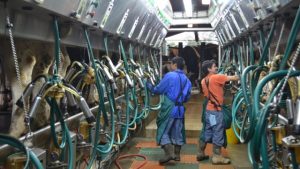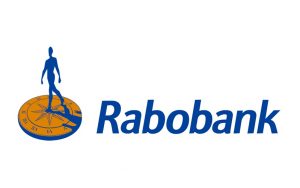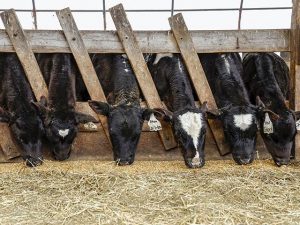
There are fewer cattle in the U.S. beef herd today than there has been in the past 65 years. According to USDA, there were 28 million head of beef cattle in the U.S. on Jan. 1 — down 2% from 2023. The shortage caused U.S. beef prices to skyrocket, and there are no signs of prices coming back down anytime soon.
At about the same time U.S. beef cattle numbers began to plummet 12 years ago due to persistent droughts in the western U.S., U.S. dairy farmers were dealing with a glut of dairy heifers after the introduction of dairy sexed semen in 2005. By 2014, there were too many dairy heifers in the U.S., and they were costing farmers more to raise than they were worth when sold, says Aerica Bjurstrom, regional Extension dairy educator for Kewaunee, Brown and Door counties in east-central Wisconsin.
“It cost them $2,200 to raise a heifer, and they were selling them for an average of $1,500,” Bjurstrom notes.
Beef-on-dairy takes off
In 2014, dairy farmers were looking for a way to reduce costs on the farm. “They were wondering, how can we raise fewer dairy heifers?” Bjurstrom says.
Now, a lot more is known about beef-on-dairy production.
“People have been raising dairy beef for generations — mostly Holstein steers,” Bjurstrom says. “But this is different. This is a whole different group of animals that somebody had to find a market for. Where are you going to get the best calf from these two industries?”
“Some of the early adopters began aggressively managing their dairy heifer inventories around 2012,” Bjurstrom says.
There are many management styles, according to Bjurstrom. Some producers are breeding all cows in their second lactation and after to beef. Some are just breeding their heifers and the top 20% of their cows to AI sexed semen from dairy bulls. The rest are bred to AI beef bulls.
“They are not turning down the money they get for these baby beef-on-dairy calves,” Bjurstrom says. “If they are raising them out, this is a nice way to use their feed refusals and add some supplements. It’s a good way to use up all the feed on their farm. But you can’t feed them like a dairy cow.”
Raising beef-on-dairy
Josh Hiemstra, 47, of Brandon, Wis., farms 790 owned and rented acres in western Fond du Lac County with his dad, Bob. They milk 140 Holstein cows and feed out 220 beef-on-dairy steers and heifers. The Hiemstras began breeding 25% of their cows to AI Angus bulls 15 years ago to create an additional revenue stream. Today, they breed all their cows to AI Angus bulls.
“Our last Holstein heifer calved in July,” Hiemstra says.
The Hiemstras plan to exit the dairy business in a few years and start custom-raising dairy heifers for a nearby farm.
“I averaged $1.75 per pound for a load of beef-on-dairy steers and heifers that I just sold,” Hiemstra says. “They averaged 1,400 pounds each. I could have been smart and sold them for $750 to $800 each as baby calves.” But he says he likes to feed them out for three reasons:
-
It allows the Hiemstras to repurpose their heifer-raising facilities.
-
The manure from the finishing operation provides good value for boosting soil health.
-
The farm can run more corn through the cattle vs. drying, storing and selling the grain.
“If I didn’t have the steers to feed the corn to, I would have to take it to town, dry it, and either store it or sell it. I’m going to make a lot more money feeding it to my steers,” Hiemstra says.
“Part of the value in finishing the steers is the cost of the calf,” he explains. “We have the calves, the facilities, and we have the feed and labor to raise them.”
Hiemstra believes every dairy farm should have a few beef-on-dairy steers to feed their refusals to, which maximizes feed efficiency.
Selling newborn calves
David Jauquet of Luxemburg, Wis., milks 675 Holstein cows with a herd average of 34,582 pounds of milk. He farms 1,100 owned and rented acres in Kewaunee County. In 2016, he started breeding the bottom 40% of his dairy herd to AI Angus bulls.
Today, 87% of his cows and 17% of his Holstein heifers are bred to AI Angus bulls. Everything else is bred to Holstein sexed semen.
“A big reason we are doing this is to create heifer calves out of our higher-end cows,” Jauquet explains. “And the beef-cross calves are worth such good money. We get $800 for a newborn beef-on-dairy calf. We sold a lot of cows for dairy in the past. This has not eliminated that, but it has shrunk it down.”
Jauquet says he likes to sell his beef-on-dairy calves when they are newborns rather than finish them out or sell more dairy heifers because:
-
You’ve got your money tied up when you raise heifers or beef-on-dairy cattle.
-
The heifer or crossbred beef calf could die.
-
Selling beef-on-dairy calves at birth is much less labor intensive.
“The way we do it saves on labor, overhead and generates more cash flow up front,” he explains. “I have a calf buyer who comes and picks up the calves on a regular route.”
Jauquet says AI sexed Holstein semen has evolved over the past 20 years and is much better today than it was when it started being used 15 to 20 years ago.
“There’s a lot of talk about conception rates,” Jauquet says. “We have a 54% overall conception rate. On the heifers, we have a 56% conception rate, and the beef, a 58% conception rate with AI Angus semen.”
More dairy heifers needed
Bjurstrom says some dairy farmers are switching back to raising a few more dairy heifers and fewer steers because there are fewer replacement dairy heifers, which has caused dairy heifer prices to rise as high as $3,000.
“But it still costs a lot to raise a heifer, even with lower feed prices, which are the highest expense with raising a heifer — you still have high costs for labor,” Bjurstrom says.
You can now read the most important #news on #eDairyNews #Whatsapp channels!!!
🇺🇸 eDairy News INGLÊS: https://whatsapp.com/channel/0029VaKsjzGDTkJyIN6hcP1K

























